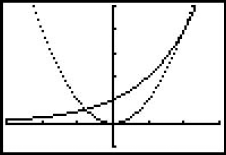18.1. The Exponential Function
18.1.1. Definition
An exponential function is one in which the independent variable appears in the exponent. The quantity that is raised to the power is called the base.
Example 1:The following are exponential functions if a, b, and e represent positive constants:
|
Realize that these exponential functions are different from the power function, y = axn. In the power function the exponent is a constant. Here the unknown is in the exponent. We shall see that e, like π has a specific value which we will discuss later in this chapter.
18.1.2. Graph of the Exponential Function
▪ Exploration:
Try this. Use your graphing calculator to graph the exponential function
- y = 2x
For comparison, graph the power function y = x2 in the same viewing window. Both functions contain the same three quantities, y, x, and 2. Are the two curves the same? What are some important differences?

Graphs of y = 2x (solid) and y = x2 (dotted). Tick marks on the horizontal axis are 1 unit apart.
Note in the screen shown at left that the graph of the exponential function is completely different from the graph of the power function. The power function graphs as a parabola, which is symmetrical about the y axis, while the exponential function has no symmetry. The power function has no asymptote (a line that a curve approaches ever ...
Get Technical Mathematics, Sixth Edition now with the O’Reilly learning platform.
O’Reilly members experience books, live events, courses curated by job role, and more from O’Reilly and nearly 200 top publishers.

